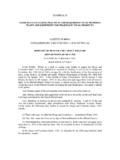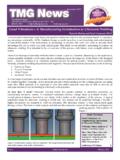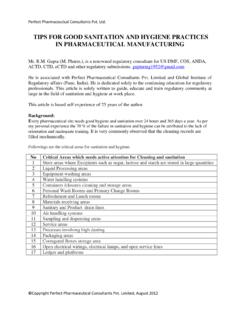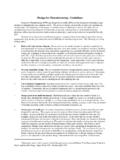Transcription of Public consultation concerning the EU template for …
1 30 Churchill Place Canary Wharf London E14 5EU United Kingdom An agency of the European Union Telephone +44 (0)20 3660 6000 Facsimile +44 (0)20 3660 5555 Send a question via our website European Medicines Agency, 2018. Reproduction is authorised provided the source is acknowledged. 26 March 2018 EMA/189939/2018 Committees and Inspections Department Public consultation concerning the EU template for GMP non-compliance statement consultation procedure: 3 April 2018 15 May 2018 1. Background Compliance with good Manufacturing Practice ( GMP ) is an essential part of the pharmaceutical quality system.
2 GMP/GDP Inspectors Working Group is currently discussing actions required after an inspection concludes that a manufacturing site does not comply with GMP, specifically where this conclusion can lead to a shortage of critical medicines. In such cases, a statement of non-compliance is the outcome of the risk-assessment of GMP-compliance of an inspected site. Following the principles of ICH Q9 the concerned member states subsequently have to decide how to manage the risk (recall, prohibition of supply, suspension of MIA etc.). Where those actions might lead to shortages of critical medicines in a particular member state of the European Union, the competent authority of that member state might decide to mitigate and accept the risk.
3 However, this risk acceptance does not change the initial risk-assessment; the site will remain non-compliant until satisfactory corrective actions are taken. The relevant parts of the Compilation of Community Procedures on Inspections and Exchange of Information (CoCP) shall be revised in order to enhance the procedure for dealing with serious GMP non-compliance by: separating processes of risk assessment and risk control; accelerating Public release of non-compliance statements; avoiding generation of conditioned GMP certificates along with non-compliance statements; providing specific guidance for Qualified Persons to facilitate release batches of critical drug products.
4 As an immediate action the template of the statement of non-compliance with GMP was updated, as reflected on pages 3 and 4 of this document. It has been agreed that the relevant procedure in the CoCP would then be amended accordingly, followed by the revision of the templates of the statements of non-compliance with good Distribution Practice and the statement of non-compliance with good Distribution Practice of a distributor of active substances for use as starting materials in medicinal products for human use. 2. consultation procedure The purpose of this consultation is to collect relevant information from stakeholders to help the GMP/GDP Inspectors Working Group to develop an effective and harmonised risk-based approach for dealing with the supply of critical medicines in case of serious GMP non-compliance amending the Compilation of Community Procedures on Inspections and Exchange of Information (CoCP).
5 Comments on the proposed updated template (see pages 3 and 4 of this document) should be submitted no later than 15 May 2018 by email to (LETTERHEAD OF COMPETENT AUTHORITY) Report No: _ _ _/_ _ _/_ __/_ _ STATEMENT OF NON-COMPLIANCE WITH GMP Exchange of information between National Competent Authorities (NCAs) of the EEA following the discovery of serious GMP non-compliance at a manufacturer1 Part 1 Issued following an inspection in accordance with Art. 111(7) of Directive 2001/83/EC, Art. 80(7) of Directive 2001/82/EC or Art. 15 of Directive 2001/20/EC.* The competent authority [Member State] confirms the following: The manufacturer.
6 Site address .. From the knowledge gained during inspection of this manufacturer, the latest of which was conducted on ../../.. [date], it is considered that it does not comply with the good Manufacturing Practice requirements referred to in the principles and guidelines of good Manufacturing Practice laid down in Directive 2003/94/EC / Directive 91/412/EEC / the principles of GMP for active substances referred to in Article 47 of Directive 2001/83/EC / Article 51 of Directive 2001/82/EC / an appropriate level of GMP as referred to in Article 46(f) of Directive 2001/83/EC.* Note to receiving authorities: Please contact the issuing authority2 within 20 working days in case there are critical3 medicinal products potentially affected by this statement.
7 Manufacturing Authorisation Holders directly affected by this statement have failed to comply with their obligations under Art. 46f/50f of Directive 2001/83(2)/EC and as a consequence the Qualified Person referred to in Art. 48/52 of Directive 2001/83(2)/EC is unable to perform the batch certification referred to in Art. 51/55 of the same Directives. In exceptional circumstances there may be no objection to the Qualified Person certifying affected batches thereby allowing their release provided all of the following conditions are fulfilled: 1. Batch certification is performed in order to maintain supply of critical medicinal products only.
8 2. A documented risk assessment has been performed by, or on behalf of, the Qualified Person and additional actions have been implemented by the manufacturing and/or batch release site to mitigate the risks posed by the non-compliance. Note: Repeated testing alone is not normally sufficient risk mitigation but, together with other actions, can form part of a strategy commensurate with the nature and the level of risk. 1 The statement of non-compliance referred to in paragraph 111(7) of Directive 2001/83/EC and 80(7) of Directive 2001/82/EC, as amended, is also applicable to importers.
9 2 This feedback shall assure that no MIAs for critical medicinal products will be suspended. 3 See Appendix 3 of the relevant procedure in the Compilation of Union Procedures. 3. A thorough risk-benefit evaluation has been performed for the acceptance of risk and a report prepared that takes full account of the nature of the non-compliance with the involvement of: The Manufacturing Authorisation Holder and the Qualified Person of the site responsible for batch certification. The manufacturing site subject to this Statement of Non Compliance, if different from the above. The relevant Marketing Authorisation Holder(s).
10 The report has been shared with the National Competent Authorities of the countries in which distribution of the affected batches is anticipated and that any comments from those authorities have been taken into account. 4. Written confirmation has been obtained from the National Competent Authorities in whose territories the affected batches are intended to be distributed that the product is considered critical on its territory, and that there is no objection to distribution. Note: Responsibility for batch certification remains with the Qualified Person. 5. The Supervisory Authority has been informed, if different from the above, and it has not suspended or revoked the relevant Manufacturing Authorisation.















